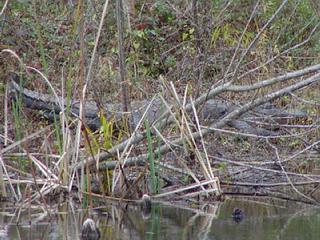 --------
--------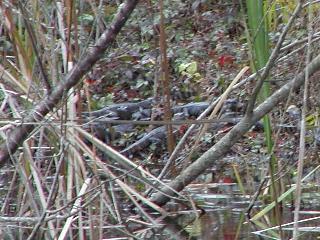 ---------------------------
---------------------------
HERES MOM HERE'S THE KIDS
This was a pretty long shot with my camera, even with the 10X zoom, and also, the plants in front of them made photographing difficult.
January
11,
2004Today's
weather
was not bad for a winter's day. Today, although it started cool,
warmed up during the afternoon. The female alligator that I saw December
28th was still in
her spot (this is the third weekend in a row). The babies
were also up on shore, and although I took some pictures, they aren't much
better than the ones I took on Dec. 28 (see below). I
suspect that she
has a den right near that area so that during the cold evenings she and
her young are protected from the severe temperature changes. Then they
just pop out and go right
onto the shore to warm up. I think that would
explain why they've been at exactly the same spot 3 weekends in a row.
December
28, 2003Today's
weather was a lot nicer than promised. It didn't rain, and the
temperature
was above 60. It was also sunny for most of the day. About 100
yards from
the parking
lot by the Elm Lake Pavilion (about halfway to the first bench
before pier #1) there was a large alligator on one of the islands.
Since
I'd seen a group of babies, and even a nest in that general
area; from
habit I normally examine the area near any large alligators I see
near,
or on, shore. Today, I was rewarded by finding a pile of baby
alligators
just behind the large on on the bank.
They were difficult to count, but
I know there were at least seven of them (not SE7EN--what an
idiotic concept).
I was able to see them without binoculars, but not clearly. This
is the
RICKUBISCAM picture. In case you can't pick out the alligators,
here's
a closer look at the mother (see HERE'S MOM, below). And here is a
closer
shot of the babies (see HERE'S THE
KIDS, below). Because of their
size, I believe that these babies are at least one year old--that
is, born
the August before the one just passed.
------ --------
-------- ---------------------------
---------------------------
HERES MOM
HERE'S THE KIDS
This
was a pretty long shot with my camera, even with the 10X zoom, and
also,
the plants in front of them made photographing difficult.
September
28, 2003Was
the weather this weekend great, or WHAT? After a lot of driving
Saturday
(to San Antonio and back), I got out to see the alligators (well,
I hoped
so) Sunday. I got
there about 8:30 am, and after getting a radio, and talking
to some people at the VC/NC, I headed out to Elm Lake. This was
about 9:00.
I hadn't been out of the car 5 minutes, when I heard
an alligator bellowing
off somewhere near the Elm Lake pavilion. I hurried around the Elm
Lake
trail, hoping to be in time to actually see some alligators
bellowing since,
if one alligator begins
bellowing, others usually answer.
I think
I was near pier number 3 when I began hearing other alligators,
just a
couple, off in the distance. As I walked down the trail towards
pier 7,
I heard one,
and then another begin bellowing. Some were in Pilant Slough,
some were in Elm Lake, and some were in Pilant Lake. This
bellowing went
on until around 10:00 am. I never got to see any of
the bellowers, but
hearing them certainly made my day (as it always does)!
Since
the greatest volume of bellowing happens in the springtime, during
mating
season, quite a few people were wondering why the alligators are
bellowing
now.
I've heard that Sharon
Hanzik, one of the Park Naturalists, feels that
they may be dividing up their territories to prepare for the
coming cool
weather. Sharon knows her stuff, and has a lot of experience at
the park
(years and years!). Sounds like a good reason to me.
I had
to head back into the VC/NC to prepare for a program I was
presenting,
but on the way back, I stopped by to check on a visitor report of
sighting
some baby alligators. Since this was near
the area where one of the nests
had been (see the August 17, and August 7 entries); I hoped that
these
were the same babies. No one had seen them for a while. I
wasn't
prepared when I
surprised them (I'd thought they were further along the
trail), and so I alarmed them. They were between me and the sun,
which
is why the photo (THERE'S THE BABY, below) is so harshly
exposed. Unfortunately,
they were already giving alarm chirps (though not frantically), so
I figured
that the mother was already alerted. So, I couldn't move around
them so
the solar glare wasn't
in my eyes, since there was water on both sides
of the trail. So, the mother could have been hidden on
either side
of the trail. I took a step, and stopped. Another step, and
stopped.
But, the
babies still chirped, and I waited for some kind of movement,
so I could be sure where the mother was. See, she could have been
near
the trail I'd already passed over. Until she made an
appearance, I couldn't
know which way to go. Until she made an appearance, I couldn't
submit gracefully
without stressing the female alligator. I don't like to
stress the
alligators.
Finally,
she showed up (see HERE COMES MOM, below), and moved straight
towards me,
with her back high. Time to leave! So, I did.
----------------------------------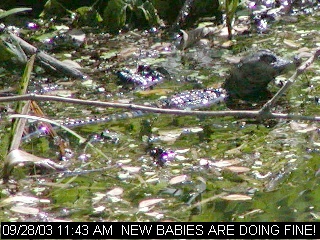 ----------
----------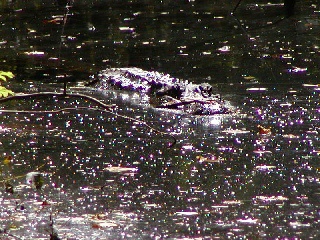
THERE'S
THE BABY
HERE COMES
MOM-
September
07, 2003It
was just a beautiful day. The weather was milder than it had been
in a
while. I was walking the trails when I spotted the alligator
in the
picture below (Baskin' Baby) lying up
near the Spillway Trail. As
I stood there, talking to park visitors, this small alligator
turned and
started down towards the water. In the meantime, another small
alligator
(there were 4 more in the
water and all of these were about 1.5-2.0 feet
long) began swimming towards the shore. Near the time the gator on
land
had turned and started walking towards the water, the other one
began
walking
up--right towards the same spot, right in front of us. There was a
small
opening pressed in the grass between the water and the trail, and
both
of these small alligators passed each other.
As they did, the one that
had been on land made a few vocalisations, which were answered a
few times
from the others in the water. The second one is in the picture
below (See
MY TURN, below)
From what I can hear, the alarm chirping of the juvenile
alligators sounds like "eeyurp! eeyurp!" with a higher pitch at
the "eey".
The "all is well", or recognition chirp sounds, to me, like "urp!
urp!"
with a sort of straight sound across the chirp. What I heard
were
these recognition chirps. It's also possible that
these alligators
were from a pod sighted in the area last year, and might just be a
year
old. In the wild, though, they grow better.
Then,
around 11:30, Sharon called me on the radio to report alligators
bellowing
near the lower-numbered piers at Elm Lake. This was a surprise,
and I was
a little disappointed. Until, about 15
minutes later, alligators started
bellowing near me on the Spillway Trail. Park visitors mentioned
that it
seemed that the alligators were bellowing all around Elm and
Pilant Lakes.
This was GREAT!
Although I couldn't see them bellow, it was still great
to hear.
---------------------------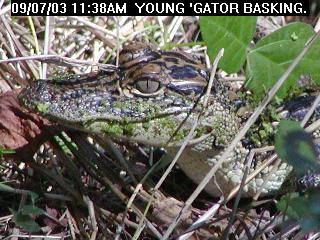 -------------
-------------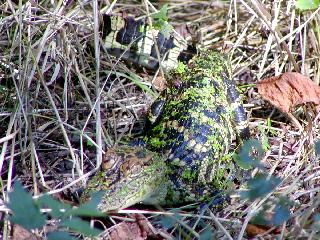 -
-
BASKIN'
BABY
IT'S
MY TURN
I'll
also mention that we only lost one of our captive-hatched
alligators from
a week and a half ago. ALL the rest are fine, strong, and eating
well!
IS THAT COOL, OR WHAT?
August
27, 2003When
the "second" alligator nest was inspected today, it was discovered
that
the eggs had hatched! Since the eggs we had in the VC/NC
came from
that nest (we had 12), it was
decided to hatch them this afternoon.
I was informed of this plan, and was able to leave work early to
help.
EXCELLENT!
Once
it was time to start, I watched one of our very knowledgeable
park
naturalists,
Sharon Hanzik, open an egg. The images below show how an expert
does it.
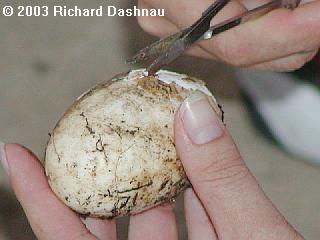 -
-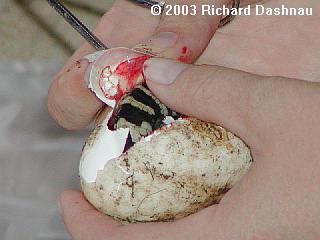 -
-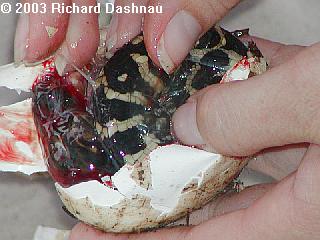 -
-
CAREFULLY
CUT
SHELL
PEEL THE
SHELL
REMOVE THE
SHELL
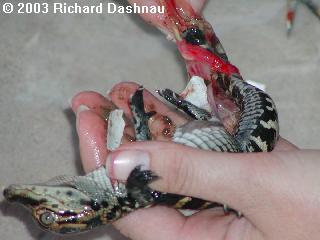
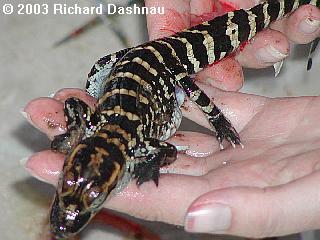
REMOVE
MEMBRANES
2003 MODEL 'GATOR!
Well,
I'd never done it before, so I was a little nervous; probably
because,
the thought of holding one of these newborn "dragons" in my
palm
while it took its first view of the world was kind of
important to me.
The
three pictures below (HATCHING part 1, 2, 3) are frames from video
that
was taken for me with my video camera by one of the rangers.
(Thanks, Dusty!).
Click on the
captions below the pictures to see the flv video clips. I
wanted to get more photos, but after my first egg, my hands were a
bit...gooey.
In the
wild, no one can say how long one of these babies would survive.
Although
they are protected by the female alligator, only one in sixty will
survive
the first three years (there were 35 in
this nest). The babies that we
have in the VC/NC usually have their survival assured, at least
for the
first year. Generally they are released after about a year and a
half--put
back into a pod of
babies with a mother in the wild. The female will accept
them and protect them, as long as they are small enough and make
the sounds
which allow the adult female to recognize them as
young alligators (though
not necessarily her offspring). It is surprising,
but babies
kept captive for a year or so will still recognize an adult female
alligator,
and will begin feeding and acting
just like the "wild" babies immediately.
They seem retain have memory at all of human contact at this age.
-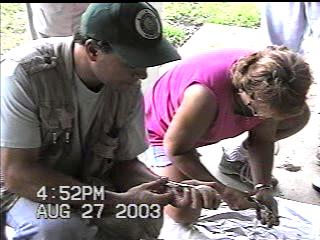 -
-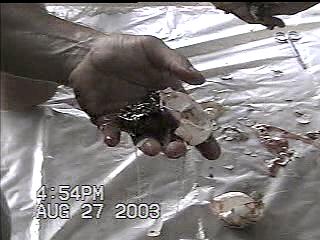 -
-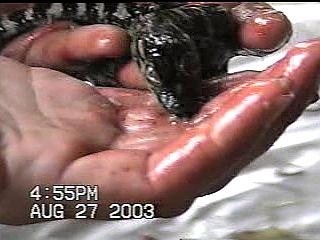 --
--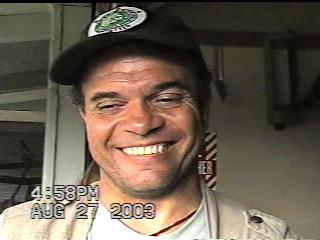
HATCHING
PART
1(859
kb)
HATCHING
PART
2(1908 kb )
HATCHING
PART 3(1809 kb)
AND
*I*
HELPED!(199
kb)
I was
able to assist the hatching of 2 eggs. The picture below (BRAND
SPANKIN'
NEW) is the baby that came out of the second one. The video clips
are from
the first egg. After I'd done the
first egg, someone (I must admit that
my mind wasn't really on the people around me. I was watching the
babies.)
said something about me looking at the camera as a proud papa. The
picture
above (I HELPED) was my response to this. Yes, there is a link to
that
clip also, since it's good to laugh now and then, even at me.
As time
permits, I'll track down some more facts about crocodilian eggs
and they
will show up here.
FURTHER
NOTE, SUNDAY AUG. 31: Out of the first 12 eggs that were
borrowed
from the nest, 11 had live young, and one was not fertile. Out of
the 11
hatched, about 4 seemed a bit
"premature". They had large yolk sacs and
were a bit weaker than the rest. Today, 4 days later, one of
the
"preemies" had not survived, though all the others seem to be ok.
Two of
those
were
still in a separate tank although showing signs of being stronger,
and one has been put in the tank with the other, bigger ones. All
of them
are vigorous and alert (see FOUR DAYS OLD, below).
Four days ago, when
the nest was found to have hatched, 3 eggs had been abandoned
there, and
three hatched babies were near the nest, covered in fire ants. But
they
were saved, and are
part of our group.
They
haven't been fed yet (normally they don't eat for about a week),
but I
was able to observe the wild siblings through a spotting scope
this morning
(they're hard to pick out),
and I saw them feeding. So, hopefully our adopted
babies will be eating soon.
------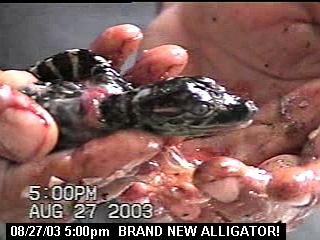 ------------------
------------------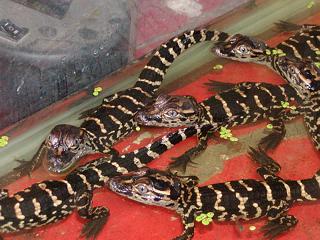 -----------
-----------
BRAND
SPANKIN' NEW
FOUR
DAYS OLD
Go back to my main alligator
page, Alligators
Go
back to my home page, Welcome
to rickubis.com
Go
back
to the RICKUBISCAM
page.
Go
back
to the See the
World
page.